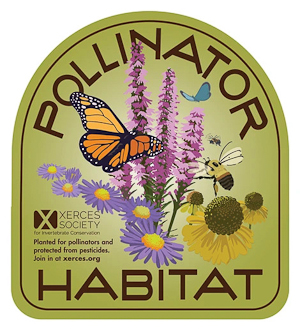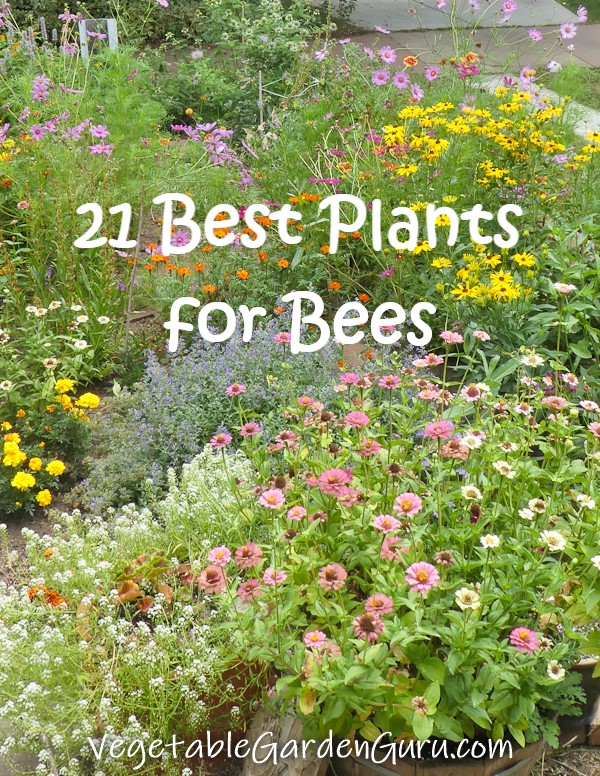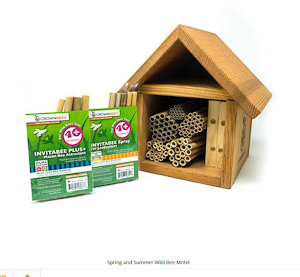- Home
- Pollinators
- How to Attract Bees
How to Attract Bees
Knowing how to attract bees is more than just knowing which
flowers are their favorites, although that is certainly a big part of attracting them. But there are different kinds of bees, and knowing a bit about their different needs can have a big impact on their ability to survive and thrive.
Safety, Flowers, Habitat and Water
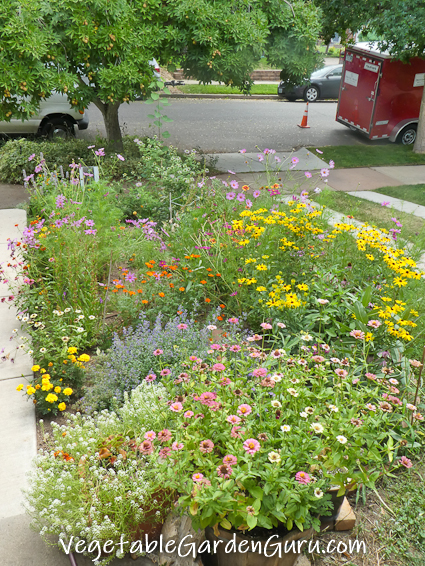 How to Attract Bees? This Small Urban Front Yard Provides Food and Shelter
How to Attract Bees? This Small Urban Front Yard Provides Food and ShelterThe four main culprits in the decline of bees are poison, lack of food, lack of habitat and lack of water.
If we want to attract bees, we need to address all four of these reasons for their decline.
Especially in urban settings, there can be significant social pressure to maintain perfect lawns, eliminate insects, and cover bare ground with something (dyed bark chips? rubber tire mulch? river rock?).
But once established, a garden full of bee-friendly flowers is a thing of beauty. This small garden in my front yard even won over my grumpy next-door neighbor, who worried that her property value would decline if there was a dandelion within a mile of her home. (And milkweed? Heaven forbid!!)
Gently educating our neighbors through beauty and signage (like the one from the Xerces Society) can greatly expand our ability to help pollinators.
How to Attract Bees:
1) Safety
Safety, to a bee, means no poisons. 'Nuff said. Don't use pesticides, herbicides, or fungicides, which are all poisons.
For killing things.
You may think that herbicide and fungicide don't affect bees, but they do. And that bag of weed-n-feed is herbicide.
If you must have a dandelion free lawn, Garret Wade makes a terrific, stand-up dandelion puller that is actually really fun to use! I can do the whole lawn in a few minutes.
How to Attract Bees:
2) Food
Bees of all kinds feed on nectar and pollen, which are produced by flowers. But some plants are more delicious and attractive to bees than others. The best flowers are the wildflowers native to your area. There are plant lists specific
If you want to attract honeybees, plant French marigolds, cosmos, borage, nepeta (catmint), chives, sage, and oregano.
If you want to attract (and help support) wild native bees, plant coreopsis, salvia, penstemon, echinacea, milkweed, hyssop, and yarrow.
I have made a free downloadable PDF of Best Plants for Bees, which features 21 of bees' favorite plants (with botanical illustrations) along with the plant's growing requirements, size and links to buy the seeds if you can't source them locally.
About ten years ago I created a dedicated Pollinator Habitat garden, and it brings me so much joy to watch and photograph all the different species of bees and butterflies flitting from flower to flower.
So why not WOW your neighbors in a different way, and instead of mowing that spotless lawn, plant a garden for the bees, which is so much more interesting! You can also join the Xerces Society (see link upper right or below) and maybe even buy a Pollinator Habitat sign to showcase your efforts, educate your neighbors while supporting Xerces' research and conservation efforts.
How to Attract Bees:
3) Habitat
You won't need to provide habitat for honey bees because they will return to their home hives at dusk (unless, of course, you decide to get into beekeeping, but that is beyond the scope of this article). They fly and gather nectar and pollen within a range of about 3 miles of their hives, visiting whatever flowers they can find within that radius.
Wild bees, which include mason bees, sweat bees, leafcutter bees and bumblebees, are largely solitary and only travel a few hundred yards from their nests, which means they will be more focused on your garden. And because they are so much "fuzzier" than honeybees, wild bees are 100 times more efficient at pollinating flowers than honeybees!
They usually live either in underground burrows that they make in undisturbed ground, or in the dried, empty stalks of dead standing plants. They almost never sting, and they are in desperate need of places to lay their individual eggs where the eggs will remain safe over the winter and then hatch out in the spring.
One of the easiest ways to provide habitat for wild bees is to leave a brush pile in some discreet place in your yard, where the ground underneath and around is bare and undisturbed. Providing tied-up bundles of dead perennial stalks in that pile will further help them find places to lay eggs. Many wild bees also need a clayey mudhole somewhere nearby, as they use clay wads to seal up their babies to keep them safe for the winter.
It is also really fun to make (or buy) a mason bee house. There is a wonderful website called CrownBees that has a ton of information on how to raise and support mason, leafcutter and other wild bees, as well as a fun selection of houses to provide habitat. they have instructions on how to build your own mason bee habitat, and if you Google "How to Make a Mason Bee House" there are many YouTubes and plans available for DIYers.
How to Attract Bees:
4) Water
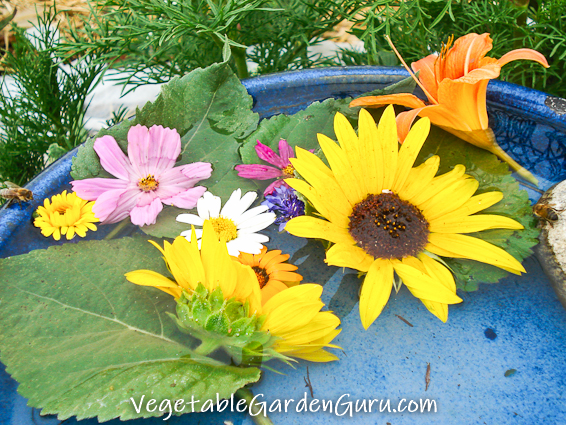 Bee Drinking Party
Bee Drinking PartyEver notice how bees tend to land around the edges of swimming pools
where kids are running around? OW OW OWW!!!! As the water splashes and starts
to evaporate, the minerals contained in the water become very
attractive to the bees.
Bees need both water and salt, and evaporating water provides both. A birdbath or shallow dish with a
variety of different-sized pebbles or stones in it provides bees a safe
place to land where they can drink without drowning, and the edge where
the water meets the stone helps concentrate the minerals as the water
evaporates. Be sure to keep an eye on it so that it doesn't dry up or
get yukky.
I also have a little fountain set up in a whiskey barrel using an old AeroGarden pump. It's all planted around the edges with snapdragons, and the fountain splashes enough around the edges that the bees have lots of wet places to land. And the peaceful sound that it makes is a lovely addition to our patio paradise.
Thanks for caring about bees and lovin' on our fuzzy friends!

Help share the skills and spread the joy
of organic, nutrient-dense vegetable gardening, and please...
~ Like us on Facebook ~
Thank you... and have fun in your garden!
Affiliate Disclaimer
This website contains affiliate links to a few quality products I can genuinely recommend. I am here to serve you, not to sell you, and I do not write reviews for income or recommend anything I would not use myself. If you make a purchase using an affiliate link here, I may earn a commission but this will not affect your price. My participation in these programs allows me to earn money that helps support this site. If you have comments, questions or concerns about the affiliate or advertising programs, please Contact Me.Contact Us Page
